South Africa
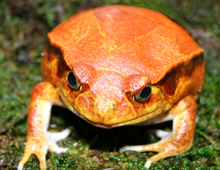
Tomato frog, Dyscophus antongilii
As with many other brightly-colored amphibians, the color of this frog indicates it can secrete an unpleasant substance when seized, in this case a thick, mildly toxic mucous. Found in a variety of habitats all over Madagascar, it has been a popular zoo animal since the 1970s, and is frequently bred in captivity. Females are larger and more colorful than males, and can reach four inches in length.
LEARN MORE
Radiated tortoise, Astrochelys radiate
This beautiful tortoise was listed as an endangered species by the US Government in 1973. In the last decade, its status has deteriorated from being classified as vulnerable to extinction, to critically endangered. People who traditionally live in its dry spiny forest habitat have a taboo against harming them. Recently, people from other parts of Madagascar have collected tens of thousands each year to eat or sell, and much habitat has been destroyed. A captive breeding program was established in the 1970s, and more than 400 live in US collections.
LEARN MORE
Madagascar giant day gecko, Phelsuma madagascarensis grandis
Most of the more than 2,000 species of geckos are nocturnal. Many are colored like bark, or in earth tones. In contrast, as their name implies, the 40 or so species of day geckos of the Indian Ocean are diurnal, and include some of the most brilliantly colored of the world’s reptiles. Instead of the cat-like slitted pupils of other geckos, they have round ones, giving them a “friendly” expression. The “Geico Gecko” in commercials is a day gecko. While some species are almost extinct, this one is abundant and often bred in zoos and private collections.
LEARN MORE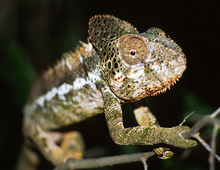
Warty chameleon, Furcifer verrucosus
Another very large chameleon of Madagascar, this lizard is slightly smaller than the very similar Oustalet’s chameleon, and differs in having fewer spikes in the crest on its back. It is also found higher up in trees.
LEARN MORE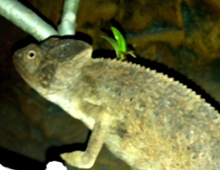
Oustalet’s chameleon, Furcifer oustatleti
Reaching 27 inches in length, this is the biggest species of chameleon. Along with insects, it eats small birds and mammals. Like other chameleons it shoots out its tongue with tremendous force to capture prey. It has a wide range in Madagascar.
LEARN MORE
Panther chameleon, Furcifer pardalis
While the familiar Green anole, often seen in local gardens, may be called the “American Chameleon”, it is actually related to iguanas and basilisks. True chameleons are an entirely Old World family. Of the 160 or so species, about half are native to Madagascar. While difficult to maintain, with proper care the Panther chameleon, from Madagascar’s tropical forests, does well in captivity. Its especially brilliant and variable colors make it popular with reptile breeders and zoos. Males can grow to 20 inches in length.
LEARN MORE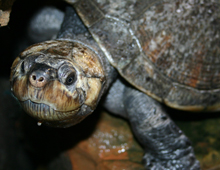
Madagascar big-headed turtle, Erymnochelys madagascariensis
This critically endangered freshwater turtle was long thought to be in the otherwise South American genus Podocmemis, which includes the Arrau and Yellow-spotted side-necked turtles, also displayed at the DWA. More recent research indicates it belongs in its own genus, but that its closest living relatives are South American, evidence of Madagascar and South America both being part of the Gondwana Super-Continent until it split apart approximately 135 million years ago. Efforts are underway to establish a captive-breeding program.
LEARN MORE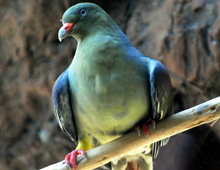
African green pigeon, Treron calva
The 23 species of Green pigeons are found in Africa, Asia and the Lesser Sundas. They are usually found in trees, where they eat fruit, especially figs. The green coloration is due to carotenoid pigments similar to those that produce the red and pink plumage of flamingos. While common over a wide area of Tropical Africa, this species is not often seen in zoos.
LEARN MORE
Great blue turaco, Corythaeola cristata
Although it is the most widely distributed of all of the 23 species of turacos, with a broad range in the forests of West and Central Africa, the Great blue turaco was very rare in zoos until the 1990s. In recent years, it has been bred repeatedly at several collections. This is one of several species of turacos that does not have the bright red wing feathers otherwise typical of this family.
LEARN MORE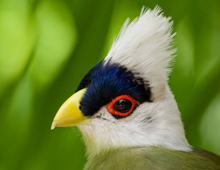
White-crested turaco, Tauraco leucolophus
Turacos are an entirely African family. Traditionally considered distant relatives of cuckoos, it has been proposed these fruit and bud-eating birds may be more closely related to owls. Found almost coast to coast across Africa, in a narrow ribbon of forest habitat, this species is popular in zoos and private collections because of its “Groucho Marx eyebrows” contrasting with its unique white head. Many have hatched since the first captive breedings in the 1970s.
LEARN MORE

